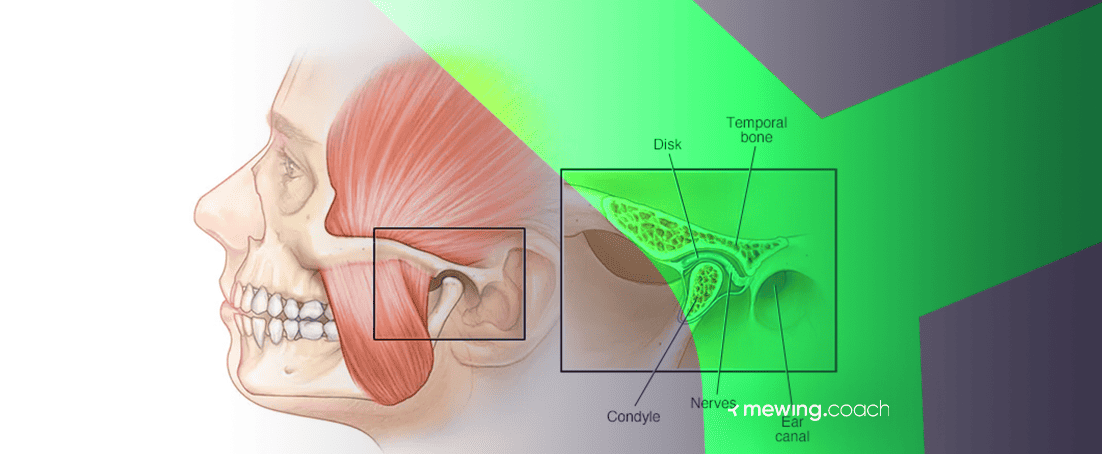The jaw is one of the most prominent features on a person’s face, but its role extends far beyond its aesthetic abilities. We use it to perform basic functions, such as talking and chewing, and any impairments that lead to difficulties can be a reason for major discomfort.
Keep reading to find out:
- ✍🏻 How poor mobility can affect the overall health
- 👄 The link between the jaw and mewing.
This article will discuss the possible reasons behind poor jaw motion and offer advice and strategies to improve mobility to achieve better overall health.

Common Problems Caused by Poor Jaw Mobility
Reduced jaw flexibility can be the cause of a list of problems that make our everyday lives more difficult than usual:
Difficulty Eating
The act of chewing is made possible by the movement of the lower jaw. When this action is made difficult or painful, eating automatically becomes a burdensome experience. Hard foods may be especially demanding, resulting in chronic pain in this area.
Speaking
Speech-language pathologists point out that limited jaw movement contributes to articulation disorders. Though differences in structure and movement do exist, as research shows, poor jaw movements can result in a lack of clarity when speaking.
Maintaining Proper Oral Hygiene
Limited jaw motion is often associated with an underdeveloped jaw. In fact, jawline classification shows that the structure of the jaw determines teeth alignment, and it can result in conditions such as over or underbite or even TMJ disorders.
Causes Behind Poor Jaw Mobility
Our jaw function is predetermined and regulated by the temporomandibular joint TMJ, also known as the jaw joint. Limited jaw movement leads to temporomandibular joint disorders (TMD), but what are the causes of these limitations?
Read on below and find out what determines whether you have a strong or weak jaw:
Poor Posture and Muscle Tension
Poor posture has a domino effect; a misaligned spine contributes to forward head posture, which strains both the neck and facial muscles. The long-term negative effects of poor posture result in frequent headaches, popping in the jaw, and overall discomfort in this part of the facial region.
Tooth Grinding and Clenching
Teeth grinding, known as bruxism in the medical field, is a condition in which a person unconsciously grinds and clenches their teeth while asleep or awake. Several factors contribute to this condition, such as high stress levels, anxiety, sleep apnea, and more.
TMJ Disorders
Prolonged tooth clenching over time becomes the reason for growing pains in the face and neck. Potentially, it can lead to temporomandibular joint disorder. This disorder directly affects the joint’s mobility; it is associated with chronic pain and reduced mobility.
Patients suffering from a TMJ disorder might find mouth-opening challenging, hear popping or clicking noises when moving their jaw, and experience overall tension in the lower jaw region. Individuals experiencing jaw hurts after waking up may also be indicative of TMJ disorders.
Jaw Injury or Surgery
Research shows that neck trauma readily results in pain and disability. Injuries, such as dislocations and fractures, often lead to problems such as jaw clenching, inability to fully close the jaw, tenderness in this region, and an abnormal appearance of the cheeks.
It is normal for patients to suffer stiffness and limited jaw movement after surgery. Still, the relationship between TMJ disorders and neck trauma remains unclear.
Rheumatoid Arthritis
Rheumatoid arthritis (RA) is an inflammatory disease in which the immune system turns against the body and attacks the joints, causing damage to their tissue. It can also cause damage to the jaw and result in chronic pain. This condition is most common in people above the age of 60.
How to Improve Your Jaw Mobility
There are numerous techniques and methods which can be used to soothe pain and restore jaw functionality:
Readjusting Tongue Alignment
Proper tongue posture can be achieved through the practice of mewing, which is praised for its many benefits, including improving face symmetry and restoring strength to your jaw.
If you browse the net to find information on mewing and its effects, you will find that some people report mewing brings about pain. If you think your jaw hurts from mewing, you are doing something wrong.
If you want to learn what mewing is all about and whether it’s the right choice for you, you can try out the Mewing.coach app, which includes detailed video guides and plenty of different jaw workout routines!
Gentle Jaw Stretches
There are many different ways in which you may go about this type of exercise, but starting with gentle stretches is recommendable. We suggest doing the following:
- Start by relaxing your jaw with your teeth slightly apart.
- Slowly open your mouth and stretch it as much as you can.
- As you do so, point your eyes toward the ceiling.
- Once you reach your “end-point,” remain in this position for a couple of seconds.
- Slowly close your mouth, look to the left with your eyes, and start moving your jaw in the same direction.
- Do so without moving your head or neck, and hold this position for a few moments before you return to the central position.
- Repeat the same on your right side.
Relax your Facial Muscles
Massage is widely known as one of the best relaxation methods, and while many still see it as a luxurious experience, others know that an at-home massage is easy to incorporate into your everyday routine.
TMJ Stretching Massage
This is a popular method used by TMJ patients as both a pain relief treatment and exercise:
- Position your thumbs parallel to your jawline, just above the mandible muscles.
- Apply gentle pressure and drag your thumbs down against your jaw.
- While doing so, slowly stretch the muscles away from the upper jaw.
Yoga and Relaxation Techniques
There is a line of yoga exercises and poses aimed at relaxing neck and jaw muscles.
You can use a simple unlocking technique as a start:
- Begin by sitting on a chair or on the floor and place your fist against your cheek.
- Without moving your hand, turn your head toward the fist.
- Gently shift this action toward your jaw and hold for one to two breaths before releasing.
Other Strategies for Improving Jaw Mobility
Aside from the exercises and techniques that we mentioned above, as a way to support jaw motion, you can incorporate other simple strategies as the following:
- Prevent tooth grinding and clenching with a mouthguard. The mouthguard will act as a protective layer and separate your two rows of teeth.
- Regular visits to the dentist for proper alignment and bite adjustment. That way, you’ll be able to eliminate any problems before they escalate.
- Dedicate time to finding training methods for the jaw that suit your needs.
- Minimize pressure by restricting hard food intake. Eat soft and chewy foods instead!
Conclusion
Healthy jaw function determines your overall health. Neglect in areas such as spine alignment and lack of focus on dental care may result in various negative effects.
Luckily, an array of techniques and stretching exercises, such as mewing and facial massage, can help treat symptoms, restore proper jaw motion and even help you achieve a more sculpted jawline. However, disciple and perseverance should be kept in mind as these are the pillars of quality jaw and dental health!




